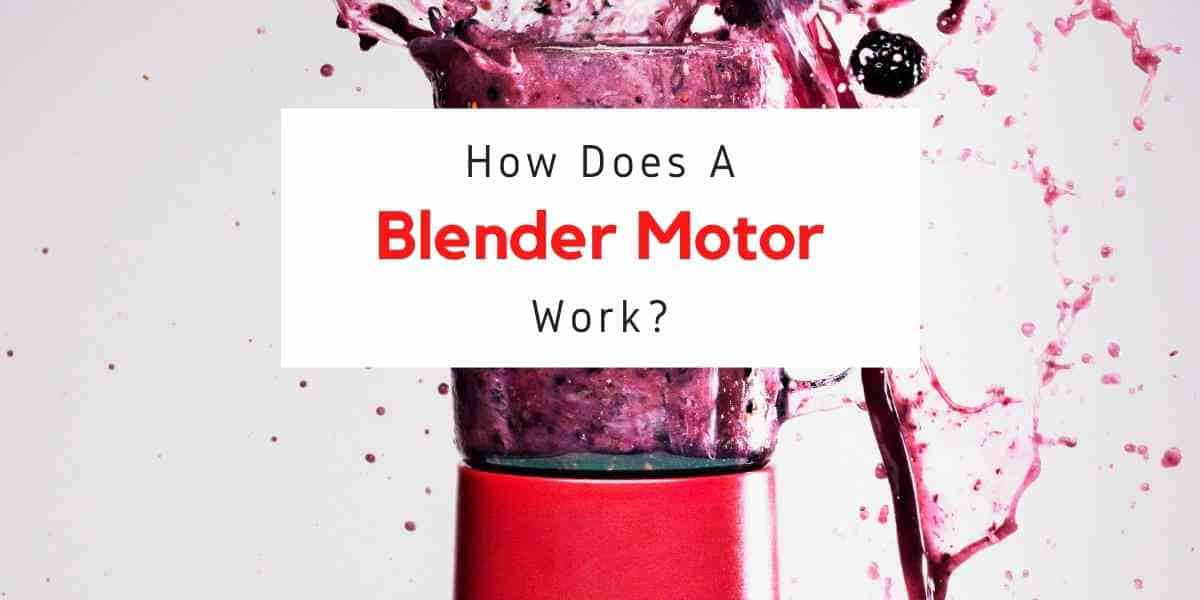It is time to talk about one of the most important parts of a blender: the motor. If you have ever used a blender, then you know that it requires a lot of power.
You’re not alone if you don’t know what a blender motor is. However, it’s important to understand how your kitchen appliances work and why they are essential to the smooth running of your home.
The blender motor is the heart of your blender. It’s what makes it go and do its thing!
Without a working motor, you’re stuck with just blending ingredients by hand.
How does this work? What makes it powerful enough to blend up ice in seconds or crush through tough ingredients like nuts and seeds? Let’s find out!
What Is A Blender Motor?
So, what is a Blender Motor? It’s the part of your blender that makes it work. The motor is responsible for turning the blades at a high speed to blend everything inside your blender container so you can have nice smoothies and shakes.
Your blender is equipped with a simple, but robust motor. It’s one of the smallest motors available on the market and uses an air-cooling system to keep it cool. This type of motor sits inside your blender’s housing unit or base.
Blenders come with a variety of cooling mechanisms. Some blenders have vents that are designed to draw the air through them, while other blenders come equipped with fans.
The small vertical coupler shaft spins very quickly when activated by an electric current and causes two blades from either side to spin, giving you a smoother drink or sauce.
The motor is situated inside of the base where it houses all of its equipment so that when it is in operation, this spinning movement can be felt at any point on the blender jar which activates these blades while also keeping all of your electronics safe from harm because they are tucked away inside their protective sheath!
How Does A Blender Motor Work?
Your blender starts with you activating the machine using the power switch.
The first thing that happens is the motor turns on.
When you turn the motor on, it will receive power from your outlet and activate our central drive shaft.
So you have a high-powered blender that does all the work for you. But how does it know which speed to be on?
A coupler is a small gear in the base of the blade assembly that connects to the blender shaft. When you turn your blender on, it spins at whatever speed you selected, and thus turns the blades inside. You can take off the blade assembly from your blender jar and see for yourself!
Think of the blender jar as a whirlpool. The blades are spinning and creating an unstoppable vortex in the glass, which is your ingredients inside it. All your liquid ingredients will be whipping around like they’re on a ride at Disney Land!
The blades in the blender create a vortex of spinning air (or liquid) that sucks up material and ingredients, then chops them into smaller bits. This process continues for as long as you want to blend your food before being pulled back down into the blades.
Yes, liquids are the key to a good smoothie. They create that vortex of ingredients that get sucked down into those blades–and you would have trouble blending dry ingredients without liquid!
How Blender Motor Controls Blending Speed
A motor control blending speed is a variable that can be adjusted to change the rate at which the blender blends. The more you adjust it, the faster it will blend.
It’s usually measured in revolutions per minute (rpm). It stands for rotations per minute and it determines how powerful a blender is.
It determines how fast a blender turns. The higher the RPM, the faster it will turn, which means you can make smoothies with less time.
When blending, sometimes you need to speed up the motor to create a vortex. However, if you are not using any liquids, then your blender is going to get louder and hotter before it cools down again.
When blending dry goods such as pesto sauce or guacamole at low speeds, only a small amount of power is being put out by the motor which slows down the blades and coupler from spinning fast enough.
When this happens, there tends to be more heat generated in the blender which could lead to damage when overheating for too long without cooling down periodically.
If you want your blender to become really powerful then all you have got do is turn it on its highest speed setting and watch as a coupler spins much faster. There are 18 different pre-set speeds for blending in some of these blenders that allow you the freedom of choosing between slow, medium, or fast rates depending on what kind of consistency you need from your drinks.
The different types of food blender settings include crush, liquefy, blend, mix and grind. These all have different levels of power which allow your blades to spin at a certain level of quickness.
Why Do I Need A New Blender Motor?
Blender motors are a critical part of your blender. If you have one that’s not working properly, it can cause all sorts of problems for you.
You might think that the motor is going to last forever and never need replacing but this isn’t true at all. In fact, there are many reasons why you may need to replace your blender motor including if something has gone wrong with it or if it just stops working altogether.
Blenders are a great way to make healthy smoothies and shakes. But let’s face it, blenders need to be replaced every few years because they get old and worn out.
And if you’re not replacing your blender motor, then you’ll notice that the machine will start making more noise than usual and may even stop working altogether.
How Can I Tell If My Blender Motor Needs To Be Replaced?
These are some telltale signs that you need to get your motor replaced –
1. Your blender is not working at all.
2. The motor sounds like it’s struggling to work.
3. You notice a burning smell coming from the blender.
4. The blades are stuck and you can’t turn them with your hand.
How Often Should I Replace My Blender Motor?
Blenders are great for making everything from smoothies, to soups, and even baby food. But the motor is what makes the blender work so it’s important to know when you should replace your blender motor.
The average lifespan of a blender is about two years before the motor starts to wear out- but this can vary depending on how often you use it and how hard you’re using it.
If your blender has been working well for more than two years then there’s no need to worry about replacing the motor yet! Just make sure that you keep an eye on any changes in performance or sound coming from your appliance.
To understand how the motor connects to the different components, here’s a post on how a blender works.








